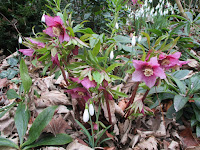When it comes to snowdrops we are twice blessed in
Gloucestershire. We have Mr Elwes’s national collection at Colesbourne Park and
carpeted acres at the Rococo Gardens Painswick.
 The current estate at Colesbourne comprises 2500 acres including
four farms and 900 acres of forest. A lake was created in 1922 in a deep wooded
valley near the house to provide hydro-electric power. The striking blue colour
of the lake is believed to be caused by the colloidal clay in the water.
The current estate at Colesbourne comprises 2500 acres including
four farms and 900 acres of forest. A lake was created in 1922 in a deep wooded
valley near the house to provide hydro-electric power. The striking blue colour
of the lake is believed to be caused by the colloidal clay in the water.
The estate tends to be open to the public for snowdrop
weekends each Saturday and Sunday in February and/or early March.
In 1874 Henry John Elwes discovered Galanthus elwesii while
travelling in western Turkey and he became one of the prominent snowdrop
collectors of his day. The present day collection is the result of the renewed
interest of Carolyn and Henry Elwes, who have devoted much time to replanting
and expanding the groups. New varieties are added each year, with the
collection now totalling some 250 varieties. Also at this time of year, inter
mingled with the snowdrops you can find hellebores, fritillaria, wood anemone,
leucojum and cyclamen.


The estate also houses a sizable arboretum In 2004 the
arboretum was visited by Owen Johnson of the Tree Register of the British
Isles, who measured many of the most notable specimens found that eight of our
trees were British champions, though as is the way with such things, several of
these are now superseded by later discoveries. They include the tallest
fastigiate hornbeam, Carpinus betulus ‘Fastigiata’ at 24 m, black oak, Quercus
velutina (28 m), both in the Ring Neadow, and the beautiful Thuja plicata
‘Semperaurescens’ (23 m) by the lake steps.
Painswick’s Rococo Gardens was designed in 1740 by Benjamin
Hyett. It is the only surviving garden of its type open to the public in this
country. Rococo describes a period of art fashionable in Europe in the 1700s,
identifiable particularly in furniture and architecture. Some of the key
features include highly ornamental decoration, the use of pastel colours and
asymmetry.
Today Painswick Rococo Garden Trust is a registered charity
and exists to restore the Garden and to educate the public about it. It has
many fun and quirky structures, nooks and crannies and is a popular wedding
venue.








